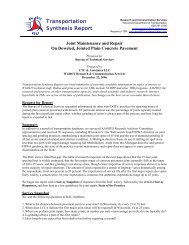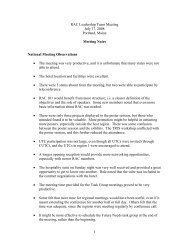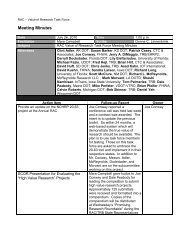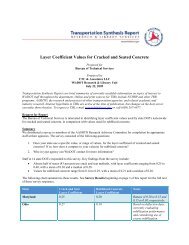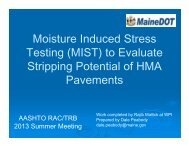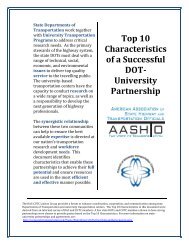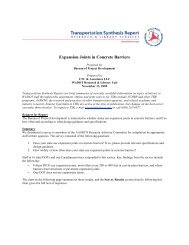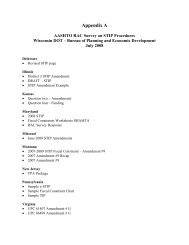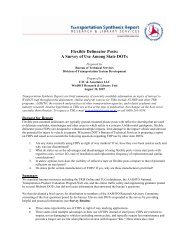Highway Maintenance Response Time Standards
Highway Maintenance Response Time Standards
Highway Maintenance Response Time Standards
Create successful ePaper yourself
Turn your PDF publications into a flip-book with our unique Google optimized e-Paper software.
coordinating with other governmental agencies and businesses to delineate the financial participation andmaintenance by the MDOT for traffic signals. This plan covers signal equipment, the installation and maintenancethereof, when one or more of the streets controlled by the signal is on the state highway system. Such participationby MDOT is contingent upon availability of funds for these purposes.III. Responsibilities. B. 3. Traffic Engineering Division (Page I-2)-a. Traffic Signal Technician will be on call 24 hours, seven days per week including holidays for the purpose ofmaking repairs.b. Dispatch Traffic Signal Technician when notification of traffic signal malfunction is received.c. Emergency repairs will be made by the Traffic Signal Technician when he is unable to restore normal operationswithin 24 hours.Western Transportation Institute, for Oregon DOT, 1999Intelligent Transportation Systems <strong>Maintenance</strong> Planhttp://www.odot.state.or.us/its/PDFs/ITSDocuments/MainPlanExecutiveSummary2900.pdf.Priority Guidelines (scroll to Executive Summary, p. vi)Having a maintenance model provides a framework for performing ITS repairs, but it provides little guidance as towhich activities should occur when. While not addressing ITS specifically, electrical repair priority guidelines inODOT’s current highway maintenance manual indicate that ITS devices would likely merit 24x7 maintenancesupport. Based on meetings with stakeholders, it was determined that there were varying perspectives on the relativerepair priority of different types of ITS devices based partly on regional needs. In order to harmonize theseguidelines across regions, stakeholders were surveyed as to how they normally prioritize repairs within theirjurisdiction. Survey results indicated that stakeholders believe that devices should be prioritized for repair not on thebasis of a particular technology but on the basis of how critical it is to the mission of ODOT. Identification ofmission-critical devices is expected to vary between urban and rural regions, as well as between summer and winterweather conditions. The following guidelines represent the general order of prioritizing repair:Fulfill legal mandates.Address safety hazards, such as devices physically impeding the safety of the traveling public or devicesproviding motorists with errant and potentially harmful information.Repair safety-critical devices, generally focusing on field devices first, communications links next, andinformation dissemination third.Repair operations-critical devices, generally focusing first on where traveler benefit is maximized.Restore all other devices, focusing first on devices that have the most visibility to the traveling public.Preventative <strong>Maintenance</strong> (scroll to Executive Summary, p. vii)Stakeholders indicated that preventative maintenance is often neglected in favor of performing repair maintenance.Efforts to emphasize preventative maintenance – through integration of preventative maintenance tasks into loggingand tracking procedures and through allocation of resources to preventative maintenance – are needed to ensure thatthese activities will not continue to be neglected.New York State DOT<strong>Maintenance</strong> and Operations First Guidance (Draft)Prepared by the Operations Division in conjunction with the 2004 Multi-year Program Update, August 2004.Page 2: A well-maintained infrastructure is vital to the transportation system mobility, reliability, safety and theeconomic competitiveness of New York State. In an effort to improve the infrastructure and transportation services,the department has adopted a <strong>Maintenance</strong> and Operations First approach to be incorporated in this Program UpdateCycle. The <strong>Maintenance</strong> and Operations First strategy provides a focus on maintenance and operations with anemphasis on systems management, operations management, response maintenance, preventive maintenance anddesign modification (corrective) maintenance.Page 2: The <strong>Maintenance</strong> and Operations First approach goes beyond the traditional asset management approachthat focuses mainly on physical assets, and instead also deals with services (such as transportation managementcenter operations and <strong>Highway</strong> Emergency Local Patrol [HELP] and systems such as Advanced TrafficManagement Systems). A key element in this new approach is recognition that ITS operations and travelerinformation services are considered as integral to the strategy. That is, these activities are essential to maintainingthe maximum availability of the capacity, mobility, reliability and safety of the system. For example, a HELP truckresponse, and resultant quicker clearance of an incident, is critical to timely restoration (maintenance) of thenormally available highway capacity.3



